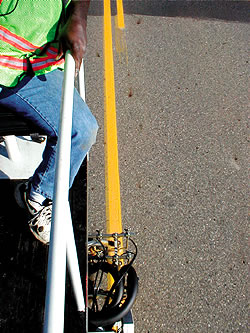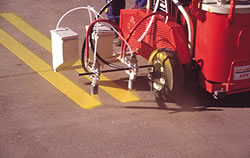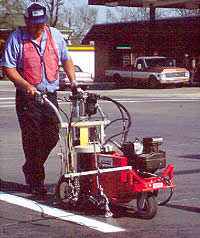
…continued from previous page
Parking Lot Striping, Traffic Paint
Waterborne vs. solvent paint — In the broadest of terms, there are two basic types of traffic paints: waterborne and solvent based. Overall, waterborne is more prominent for long stripers while solvents are preferred by many in the parking lot business.
by David Thompson
In the broadest of terms, there are two basic types of traffic paints: waterborne and solvent based. Overall, waterborne is more prominent for long stripers while solvents are preferred by many in the parking lot business.
“Waterborne’s advantages are similar to those of house paint. It’s easy to work with and it cleans up with water. Plus, fumes are minimized with latexes,” Wood says.
Acrylic latex also has much better color retention, says Ron Boyajian, product marketing manager for California Paints. “Solvents tend to fade more rapidly,” he notes.
Prior to 1990, 99 percent of the paint used for roadways was oiled-based alkyd or solvent paint, and much of it contained lead, says Vermeer. “About 1990, the transition started to move more toward environmentally friendly, waterborne, lead-free materials. Today, I’d say conventional traffic paint consists of 95 percent latex and 5 percent alkyd.”
“There’s a new generation of [latex] products that performs better than the old alkyd-based paints,” Vermeer continues. “They are longer lasting and have better bead retention.”
Strength in traffic paints comes from the resins that were developed specifically for these products, Smith says. “They have excellent adhesion to both concrete and asphalt. This is where good formulation knowledge comes into play, as most of these products are run over and pounded by 80,000-pound vehicles within 1 to 2 minutes of application.” Their strength depends on “a good balance of resin quality, drying characteristics, abrasion resistance and glass bead embedding.”
Latex has taken off everywhere except in the Northeast and other areas where the winters are severe, says Boyajian, whose company, California Products Corp., is headquartered in Massachusetts.
 In colder climates, Wood says, many parking lot contractors still choose the more expensive chlorinated rubber. “In simple terms, it’s like a regular alkyd paint with an extra resin which provides extra durability and increases dirt resistance. It handles similar to an alkyd and you don’t notice a difference until it starts to dry. It gets tougher.” In colder climates, Wood says, many parking lot contractors still choose the more expensive chlorinated rubber. “In simple terms, it’s like a regular alkyd paint with an extra resin which provides extra durability and increases dirt resistance. It handles similar to an alkyd and you don’t notice a difference until it starts to dry. It gets tougher.”
Chlorinated rubber is by far the most popular chemical compound, says Lauretta Taddeo, who does support and marketing for Franklin Paint Co. in Franklin, Massachusetts. “It’s a superior product.” But, she cautions, it is a hazardous material and disposal is an issue.
“Solvent paints work better under suspect surface conditions and dry more consistently under a wider variety of ambient conditions. They extend the striping season because they can be used in cooler weather,” Wood continues. “Latexes are less likely to perform well below 50 degrees [Fahrenheit].”
Taddeo says she doesn’t recommend laying paint when it’s below 20 degrees outside, “but they still do it. Solvent-based paints won’t freeze. And that’s one of the biggest advantages of the alkyd and the chlorinated rubber.”
However, you can’t use alkyds everywhere. A lot of parking lots are sealed with a coal tar emulsion, and solvent paint will bleed when you paint on top of that, Wood says. “Generally, you have to use a latex paint on those types of newly sealed asphalt surfaces.”
Most manufacturers maintain that although traffic paint is made by different companies, the paint itself is much the same and can be used in various regions. Smith, of Ennis Paints, disagrees. “That’s why we make 150 different kinds of both white and yellow traffic paint,” he says.
“Paints are formulated to meet different drying needs,” he continues. “Most specifications are written around testing at standard conditions which very seldom exist in the real world. There are many factors that affect drying time, such as temperature, humidity, wind speed, barometer readings and substrate. Waterborne paints dry much slower at higher humidity and will not dry below dew point. The effect is less on solvent paints.”

Whereas priming is key to a good paint job elsewhere, it has no place on the road or in the parking lot. One coat is the norm for striping.
About the only preparation necessary for traffic paint is a good brooming, Vermeer says. “The road should be cleaned with a power broom or air jets. No one does anything beyond that.” Still, he acknowledges, the better the surface prep, the better the bond between the surface and material.
New surfaces should be etched, and should be dry. “Latex paint will still perform on wet surfaces but it will dry much slower,” Vermeer says.
As a rule of thumb, Smith adds, do not apply a product until 24 hours after a rain.
The bulk of the roads in this country need to be painted every one to two years, Vermeer says, but some paint jobs can last three to four years.
“Durability is dependent on the paint quality and type of product used,” Smith explains. “Most products perform well for up to one year, those being the standard waterborne and solvent-borne products. Longer-life waterborne products perform well for two years and into the third year depending on the severity of the winters. High-traffic roads require more frequent painting than secondary roads.”
Equipment to apply traffic paint varies from a very simple walk-behind to a computer-operated machine capable of painting multilane lines at speeds up to 20 miles per hour.
As far as airless and air atomized equipment, Vermeer says he’s seeing the industry leaning more toward airless equipment these days, both for striping trucks and walk-behinds. “The latex paint applies real nice with the airless,” he says.
But pay attention to the equipment’s makeup, advises Smith: “Equipment for waterborne application needs to be all stainless steel, as waterborne reacts with galvanized metals, aluminum, brass and mild steel causing buildup in the machine and gelling of the material.”

|

